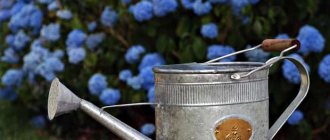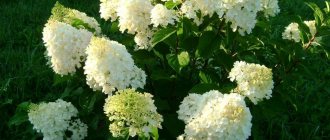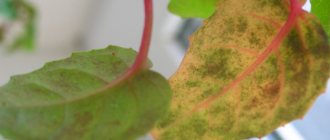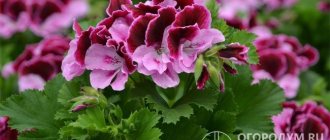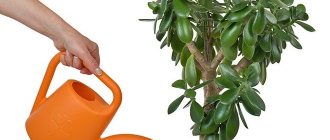Author: Elena N. https://floristics.info/ru/index.php?option=com_contact&view=contact&id=19 Category: Garden plants Published: February 18, 2019Last edits: January 13, 2021
When the days become noticeably shorter and the air smells of frost, it means it’s time to prepare your garden shrubs for winter. The responsibility of this event can hardly be overestimated: not only their flowering next season, but also their overall health depends on how you prune and cover your ornamental shrubs. In our climate, three types of hydrangea are usually cultivated: paniculate, tree-like and large-leaved. And each of them requires a special approach. From our article you will learn:
- how to prune each variety of hydrangea in the fall;
- how to prepare them for winter;
- how to protect them from winter frosts.
Listen to the article
Hydrangea (lat. Hydrangea) are flowering plants of the Hydrangeaceae family, of which in nature, according to various sources, there are from 30 to 80 species. Among them are shrubs and small trees, growing mostly in East and South Asia, China, Japan, the Far East, and the Americas. The plant was named after Princess Hydrangea, whom no one remembers for a long time; later, when botanists were engaged in systematizing plants, hydrangea received the Greek name Hydrangea, which translates as “vessel with water” - the shape of the plant’s seed pods resembles a jug, and the plant itself is very loves water.
The Japanese call hydrangea "ajisai", which means "purple sun flower". It was from Japan that hydrangea was brought to Europe in 1820, and at first it was grown only as a houseplant due to its low winter hardiness, but breeders were so keen on cultivating hydrangea that by the middle of the 20th century more than 100 garden varieties were created. In our latitudes, garden hydrangea is represented quite widely - twelve popular species.
Varieties and varieties of climbing hydrangea with photos
The climbing plant has many varieties. The most popular are these.
Petiolaris
It is considered the largest vine of all climbing hydrangeas. It is petiolaris that can reach 25 meters in length and entwine an entire house.
Cordifolia
Blooming cordifolia, painted in delicate creamy tones, leaves no one indifferent.
This dwarf (compared to its companions) one and a half meter vine is notable for its unusual leaf color: the upper part of the leaf plate is green, and the lower part has a light, almost white tint.
Miranda
This variety is interesting for its unusual pointed shape of leaf plates covered with light veins.
Take a chance
It is considered one of the most attractive vines. Thanks to the light edging on the leaves, this hydrangea does not lose its high decorative qualities even outside the flowering period.
Winter surprise
The foliage of this medium-sized hydrangea is remarkable: it tends to change color from dark green to cherry when exposed to frost.
Silver lining
The pleasant aroma of this hydrangea flowers attracts bees. The plant can grow a little more than 5 meters, and is often used in garden design as a ground cover plant.
Botanical description
Most of the hydrangea species are shrubs with a height of 1 m to 3 m; among hydrangeas there are both trees and vines that climb tree trunks to a height of up to 30 m. Among the representatives of the genus there are evergreen species, and there are deciduous ones, but in our latitudes they are grown namely the latter, blooming from spring to late autumn. Two types of flowers are collected in spherical inflorescences at the ends of the stems - sterile at the edges and fertile in the middle of the inflorescence. The flowers are most often white, but a species such as large-leaved hydrangea is represented by varieties with pink, blue, lilac and red flowers, and the acidity of the soil determines the color of the specimen. For example, hydrangeas with blue flowers grow in acidic soil, lilac and pink flowers in alkaline soil, and soft beige flowers in neutral soil. The fruit of hydrangea is a multipartite capsule with seeds.
- Ivan tea: cultivation, properties, how to collect and dry
In addition to large-leaved hydrangea, tree hydrangea grows well in our climate, known for its winter hardiness and ability to recover well from severe frosts. Paniculata hydrangea also overwinters well, known for its longevity - it can grow in one place for up to 60 years.
In addition to these three most popular species, such species as serrate hydrangea, serrate hydrangea, climbing hydrangea, radiant hydrangea, Sargent hydrangea, petiolate hydrangea, oakleaf hydrangea and others are known in floriculture.
Wintering
Petiolate hydrangea is a frost-resistant plant that can withstand even harsh winters. But it is recommended to remove young seedlings from their support within 2-3 years and make a light shelter in case of a snowless, frosty winter. An adult plant easily recovers after freezing, continuing to develop and bloom well in the future, so there is no need to remove it from its support.
Due to its winter hardiness, this crop is grown in the Moscow region and even in Siberia. That is why domestic gardeners and designers are increasingly using petiole hydrangea today to decorate their garden plots.
Pruning hydrangeas after flowering
Caring for hydrangea involves, among other things, pruning it. Some amateur gardeners claim that hydrangea is like lilac - the more you prune, the more luxuriantly it blooms the next year. This is not entirely true, since this statement is true for paniculate and tree hydrangeas, but colored (large-leaved) hydrangeas cannot be pruned. Large-leaved hydrangea blooms on last year's shoots, so young branches that grew this summer must overwinter, and only next year they can bloom.
As for the species with white flowers, namely paniculate and tree hydrangeas, they bloom on annual stems, so after pruning, as stated, they will have many young shoots that will produce more flowers. It is recommended to prune hydrangeas in the spring, but this must be done carefully, since sap ferments in the plants, and they “cry” when pruned. Many gardeners believe that it is better to prune hydrangeas in the fall.
Based on these differences between species, hydrangeas were divided into two groups based on pruning quality. The first group includes species that bloom on last year's shoots, such as the already mentioned large-leaved hydrangea, as well as serrated, prickly, Sargent, oak-leaved and petiolate liana-shaped hydrangeas. Pruning of these hydrangeas can only be cosmetic, removing last year's inflorescences down to the first pair of strong buds and weak, old shoots completely.
The second group includes species in which buds form on the shoots of the current year: paniculate hydrangea and tree hydrangea. The main pruning of these types of hydrangeas is usually done in the spring, before the start of the growing season. Tree hydrangea is subjected to the procedure only if it is already four years old, otherwise it may die, bleeding juice. However, if you prune in the fall, this problem will not happen. An adult, and especially an old plant that needs to be rejuvenated, is cut “to the stump”, that is, only 10 cm are left from each shoot.
- Video about growing gerbera from seeds
If the bush is too large and old, there is no need to prune it at once, otherwise the short shoots will not be able to feed the large root mass. Rejuvenate the bush in parts over three years.
Paniculate hydrangea is pruned sparingly, like a tree, without touching the skeletal branches: of the several shoots that grow from one point, only those that grow outward are left.
Pruning hydrangeas in the fall is absolutely safe and will ensure your plant blooms luxuriously next year. In hydrangea species of the second group, the inflorescences are cut off so that the fragile branches of the plants do not break under the weight of the snow that sticks to them in winter - this is the case if you do not intend to cover the hydrangea for the winter. In addition, old thick stems are removed from tree hydrangea, and weak thin shoots from paniculata hydrangea, and annual growth is shortened by 2-5 buds.
Watering regime in autumn
Hydrangea is a moisture-loving plant; water it regularly with plenty of water. However, this rule applies to the spring and summer seasons. In autumn, abundant watering of hydrangea is contraindicated. In September, the plant stops watering. An exception can be made if it is a warm and dry autumn. Under such conditions, the bush can be watered 1-2 times.
Preparing hydrangea for winter
Caring for paniculata hydrangea in the fall (and other species too), on the eve of the onset of cold weather, involves covering the hydrangea for the winter. Unfortunately, not a single type of hydrangea can winter in our area without insulation, so preparing garden hydrangeas for winter must be thorough. The tree hydrangea is the most winter-hardy, but it also needs shelter for the winter, otherwise the ends of its young shoots may freeze.
Start preparing in mid-September: remove all leaves except the top ones in order to speed up the process of lignification of the shoots, and feed the plants with phosphorus-potassium fertilizers (hydrangea is not fertilized with nitrogen in the fall). Now you can cover the hydrangea.
Treatment against diseases and pests
The flowering of a diseased plant becomes scarce. To protect hydrangea from diseases and pests, preventive treatment is carried out in the fall. For spraying, use 3% Bordeaux mixture.
The composition is quite toxic; when working with it, wear a respirator, safety glasses, and closed clothing. After spraying the bush, the remaining solution is poured into the tree trunk area. Pests and their larvae often hide in the top layer of soil for the winter.
How to cover a hydrangea for the winter
There are several methods of shelter, but it all depends on what kind of winters are in your area. In the southern regions, it is often enough to simply hill up a bush of tree or paniculate hydrangea high. If your winters are unpredictable, then it is better to play it safe and still cover your hydrangeas. Small plants can be completely covered with peat and covered with a film on top - don’t be afraid that the plant may get wet, this probably won’t happen.
A well-proven method allows you to cover a small young plant without causing harm to it: tie a rope around the bush and pull it slowly, without jerking, to boards laid on the ground with nails driven in, to which you tie the plant. Then cover it with spruce branches or sawdust, and cover it with a sheet of old iron, lutrasil grade 30 or spunbond.
- Comb celosia - how to plant it and what should you water it with after?
Another method: the trunk circle is covered with spruce branches, the hydrangea shoots are bent to the ground radially, away from the center of the bush, the bases of the laid shoots are secured with brackets made of wood or metal and the center of the bush is covered with peat, spruce spruce branches are laid on top of the lying shoots, which is covered with lutrasil. Lutrasil needs to be pressed down with boards and bricks to prevent it from being blown away by the wind. This hydrangea shelter can withstand temperatures of -40 ºC.
It will be difficult to bend old powerful bushes to the ground, so the following method of covering them for the winter is provided: the bush is wrapped in lutrasil, which is fixed with twine or tape, then a metal mesh frame is installed above the bush, which should be 12-15 cm higher than the covered plant Large quantities of dry leaves are placed inside the frame, and the structure is covered with roofing felt or plastic film on top.
Every year, the winter hardiness of hydrangea increases, and over time you can refuse to cover adult bushes, but young plants should be covered in any case in the first years of their life, even if the winter turns out to be warm.
Reproduction
New plants are obtained from seeds and vegetative propagation methods .
Growing from seeds
This method is time-consuming and labor-intensive, but makes it possible to obtain a large number of seedlings.
- Seeds are sown in a container with nutrient soil.
- Cover with film or glass, opening daily for ventilation.
- Water with a spray bottle as needed and keep in a warm, well-lit place.
After about 50 days, shoots will appear. The appearance of cotyledon leaves will be a signal to pick seedlings.
Cuttings
The material is harvested in the spring before flowering begins . For pruning, choose young but strong shoots with two nodes. The length of the cutting can reach 15 cm. The top is shortened, and the lower cut is treated with a root formation stimulator. The cuttings are planted in a container filled with a mixture of sand and peat and covered with film.
Dividing the bush
This method is quite complicated, given the size of the vine . Smaller varieties are usually propagated this way because they can be dug up without damaging the plant.
The root ball is carefully removed from the ground, shaken off and cut into 2-3 parts. Each of them is nurtured as an independent plant.
By layering
A trench is dug next to the bush, where one of the lower shoots is bent, fixing it. The appearance of roots on the layering is a signal to the gardener that the new plant needs to be separated from the mother plant, finding a new cozy place for it.

